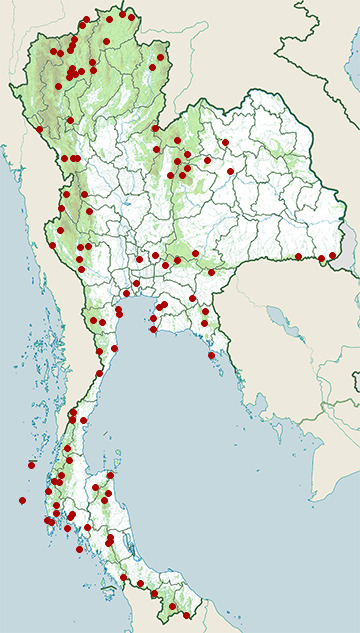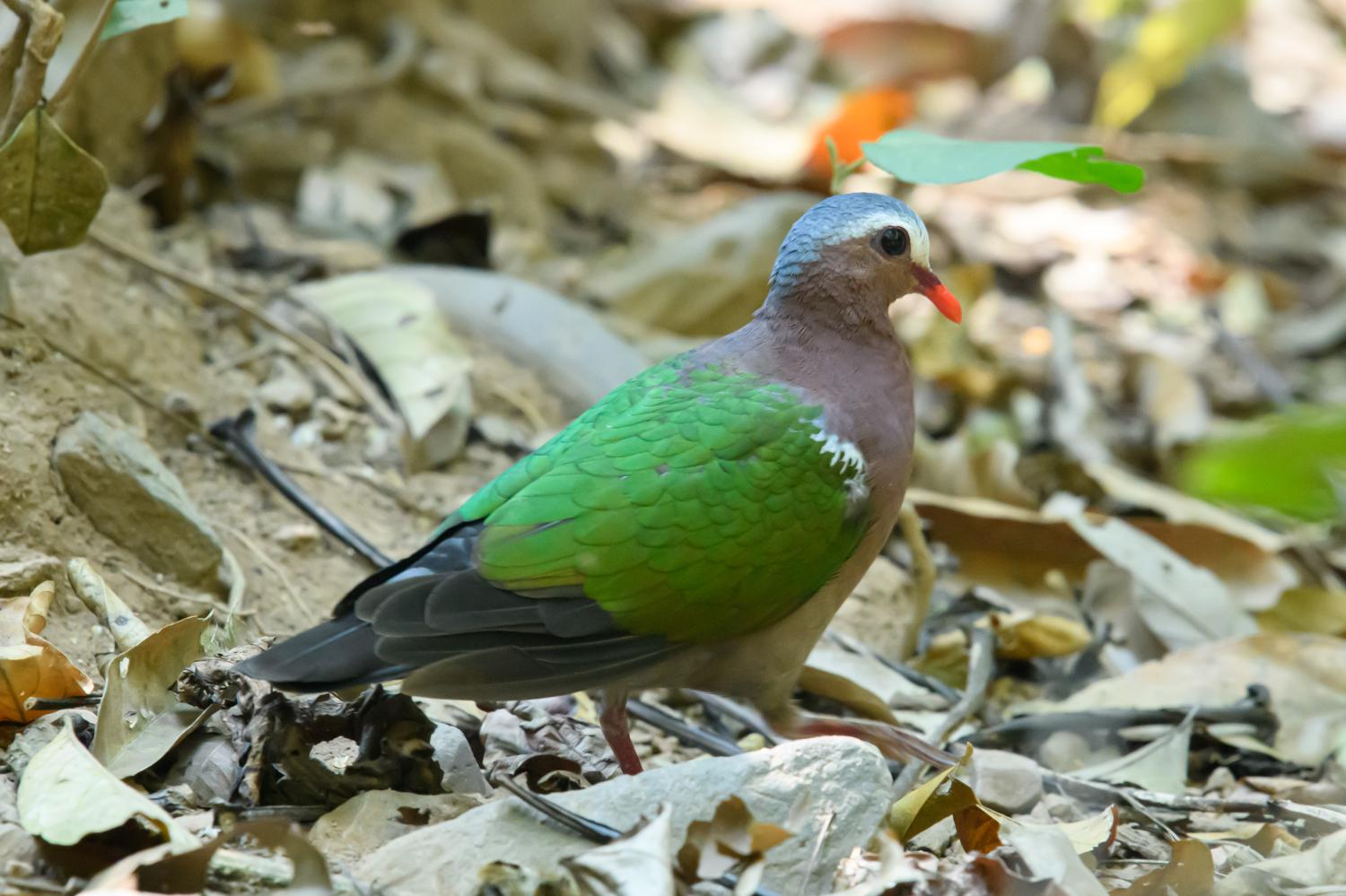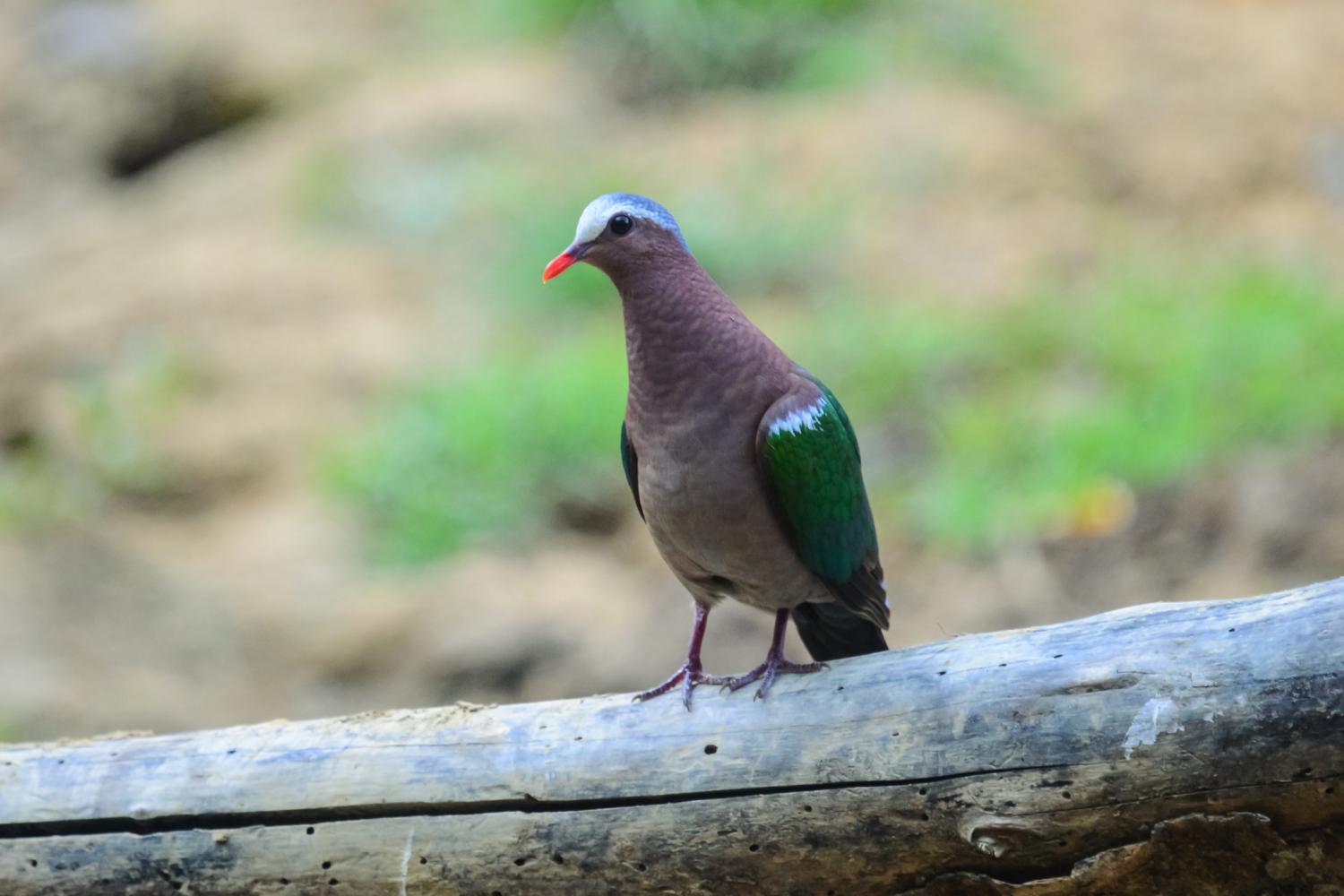Species of Thailand
Common emerald dove
Chalcophaps indica
Carolus Linnaeus, 1758
In Thai: นกเขาเขียว
The common emerald dove (Chalcophaps indica), also called Asian emerald dove and grey-capped emerald dove, is a widespread resident breeding pigeon native to the tropical and subtropical parts of the Indian Subcontinent and Southeast Asia. The dove is also known by the names of green dove and green-winged pigeon. The common emerald dove is the state bird of the Indian state of Tamil Nadu. The Pacific emerald dove and Stephan's emerald dove were both considered conspecific.
Taxonomy
In 1743 the English naturalist George Edwards included a picture and a description of the common emerald dove in his A Natural History of Uncommon Birds. He used the English name "Green Wing'd Dove". His drawing was made from a live bird at the home a merchant in Rotherhithe near London. Edwards was told that the dove had come from the East Indies. When in 1758 the Swedish naturalist Carl Linnaeus updated his Systema Naturae for the tenth edition, he placed the common emerald dove with all the other pigeons in the genus Columba. Linnaeus included a brief description, coined the binomial name Columba indica and cited Edwards's work. The specific epithet indica is Latin for "Indian" and is used by Linnaeus to denote the East Indies. The species is now placed in the genus Chalcophaps that was introduced by the English ornithologist John Gould in 1843.
Six subspecies are recognised:
- C. i. indica (Linnaeus, 1758) – India to south China, Malaysia, Philippines, Indonesian and west Papuan islands
- C. i. robinsoni Baker, ECS, 1928 – Sri Lanka
- C. i. maxima Hartert, 1931 – Andaman Islands
- C. i. augusta Bonaparte, 1855 – Nicobar Islands
- C. i. natalis Lister, 1889 – Christmas Island (Indian Ocean)
- C. i. minima Hartert, 1931 – Numfor, Biak and Mios Num islands (off north New Guinea)
Description
The common emerald dove is a stocky, medium-sized pigeon, typically 23-27 cm in length. The back and wings are bright emerald green. The flight feathers and tail are blackish, and broad black and white bars show on the lower back in flight. The head and underparts are dark vinous pink, fading to greyish on the lower belly. The eyes are dark brown, the bill bright red and legs and feet rufous.
The male has a white patch on the edge of the shoulders and a grey crown, which the female lacks. Females will tend to have a browner complexion with a grey mark on the shoulder. Immature birds resemble females but have brown scallops on their body and wing plumage.
Distribution and habitat
This is a common species in tropical forests and similar dense wet woodlands, farms and mangroves. It builds a scant stick nest in a tree up to five metres and lays two cream-coloured eggs.
Behaviour and ecology
Emerald doves usually occur singly, pairs or in small groups. They are quite terrestrial, often searching for fallen fruit on the ground and spending little time in trees except when roosting. They eat seeds and fruits of a wide variety of plants and are generally tame and approachable.
Its flight is fast and direct, with the regular beats and an occasional sharp flick of the wings which are characteristic of pigeons in general. It often flies low between the patches of dense forest it prefers, but when disturbed will frequently walk away rather than fly. They are particularly good weavers when flying through forests. When flying they expose a buff underwing and a chestnut colour of their flight feathers.
The call is a low soft moaning cooing consisting of about six to seven coos starting quietly and rising. They also call a nasal "hoo-hoo-hoon". Males perform a bobbing dance during courtship.
This article uses material from Wikipedia released under the Creative Commons Attribution-Share-Alike Licence 3.0. Eventual photos shown in this page may or may not be from Wikipedia, please see the license details for photos in photo by-lines.
Category / Seasonal Status
BCST Category: Recorded in an apparently wild state within the last 50 years
BCST Seasonal status: Resident or presumed resident
Scientific classification
- Kingdom
- Animalia
- Phylum
- Chordata
- Class
- Aves
- Order
- Columbiformes
- Family
- Columbidae
- Genus
- Chalcophaps
- Species
- Chalcophaps indica
Common names
- English:
- Common emerald dove
- Emerald dove
- Grey-capped emerald dove
- Asian emerald dove
- Thai: นกเขาเขียว
Conservation status

Least Concern (IUCN3.1)
Photos
Please help us review the bird photos if wrong ones are used. We can be reached via our contact us page.
Range Map

- Ao Phang-Nga National Park
- Ban Bueng District, Chonburi
- Bang Lamung District, Chonburi
- Bang Lang National Park
- Bangkok Province
- Chae Son National Park
- Chaloem Rattanakosin National Park
- Chiang Dao District, Chiang Mai
- Chiang Dao Wildlife Sanctuary
- Chiang Khong District, Chiang Rai
- Chiang Saen District, Chiang Rai
- Doi Inthanon National Park
- Doi Lang
- Doi Pha Hom Pok National Park
- Doi Phu Kha National Park
- Doi Saket District, Chiang Mai
- Doi Suthep - Pui National Park
- Erawan National Park
- Hala-Bala Wildlife Sanctuary
- Huai Kha Khaeng Wildlife Sanctuary
- Huai Nam Dang National Park
- Huai Yang Waterfall National Park
- Kaeng Krachan District, Phetchaburi
- Kaeng Krachan National Park
- Kaeng Krung National Park
- Khanom District, Nakhon Si Thammarat
- Khao Ang Rue Nai Wildlife Sanctuary
- Khao Banthat Wildlife Sanctuary
- Khao Chong
- Khao Khitchakut National Park
- Khao Laem National Park
- Khao Luang National Park
- Khao Nam Khang National Park
- Khao Nan National Park
- Khao Phanom Bencha National Park
- Khao Phra - Bang Khram Wildlife Sanctuary
- Khao Phra Thaeo Wildlife Sanctuary
- Khao Pu - Khao Ya National Park
- Khao Sam Roi Yot National Park
- Khao Soi Dao Wildlife Sanctuary
- Khao Sok National Park
- Khao Yai National Park
- Khlong Saeng Wildlife Sanctuary
- Khon San District, Chaiyaphum
- Khun Chae National Park
- Ko Chang National Park
- Ko Lanta National Park
- Kromluang Chumphon Wildlife Sanctuary
- Kui Buri National Park
- Laem Pak Bia
- Lan Sang National Park
- Mae Chan District, Chiang Rai
- Mae Moei National Park
- Mae Ping National Park
- Mae Rim District, Chiang Mai
- Mae Sot District, Tak
- Mae Wong National Park
- Mueang Chiang Mai District, Chiang Mai
- Mueang Chumphon District, Chumphon
- Mueang Khon Kaen District, Khon Kaen
- Mueang Krabi District, Krabi
- Mueang Nakhon Nayok District, Nakhon Nayok
- Mueang Phang Nga District, Phang Nga
- Mueang Samut Sakhon District, Samut Sakhon
- Nam Nao National Park
- Namtok Sam Lan National Park
- Op Khan National Park
- Pai District, Mae Hong Son
- Pak Thale
- Pang Sida National Park
- Pha Daeng National Park
- Phan District, Chiang Rai
- Phanom Dong Rak Wildlife Sanctuary
- Phato District, Chumphon
- Phi Phi Islands
- Phra Nakhon Si Ayutthaya District, Phra Nakhon Si Ayutthaya
- Phu Chong Na Yoi National Park
- Phu Foi Lom National Park
- Phu Hin Rong Kla National Park
- Phu Khiao Wildlife Sanctuary
- Phu Kradueng National Park
- Phu Luang Wildlife Sanctuary
- Phu Suan Sai National Park
- Phu Wiang National Park
- Sadeth Naikrom - Krom Luang Wildlife Sanctuary
- Sai Yok District, Kanchanaburi
- Sakaerat Environmental Research Station
- San Kala Khiri National Park
- Sattahip District, Chonburi
- Si Racha District, Chonburi
- Si Sawat District, Kanchanaburi
- Similan Islands
- Sirinat National Park
- Sri Phang-nga National Park
- Surin Islands
- Tai Rom Yen National Park
- Taksin Maharat National Park
- Takua Pa District, Phang Nga
- Tat Mok National Park
- Thale Ban National Park
- Tham Sakoen National Park
- Thong Pha Phum National Park
- Thung Yai Naresuan Wildlife Sanctuary
- Umphang Wildlife Sanctuary
- Wang Mai Forest Restoration Project
- Yod Dom Wildlife Sanctuary





